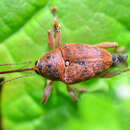Biology
provided by Arkive
Adults feed on oak (1). The females lay their eggs in acorns; the long rostrum is used to bore through the thick wall of the nut (3) with jaws located at the tip of the rostrum. When it has almost reached the centre of the nut, the egg is inserted in the hole, which subsequently heals up (4). The larvae develop inside the acorns, burrowing out when they are fully-grown in order to pupate in the soil, leaving a small hole in the wall of the acorn (2).
Conservation
provided by Arkive
Not relevant.
Description
provided by Arkive
The most striking feature of the acorn weevil is its elongated snout, known as a 'rostrum', which is longer in females than males (2). Adults have a brownish and patterned body (1). The larvae are short, and cylindrical in shape, and move by means of ridges on the underside of the body (2).
Habitat
provided by Arkive
This species is found on oak trees (2).
Range
provided by Arkive
Found mainly in southern and central parts of Europe, becoming increasingly rare further north (2). In the UK, the acorn weevil has a wide distribution in the south (1).
Status
provided by Arkive
Common and widespread (3).
Threats
provided by Arkive
This species is not threatened at present.
Associations
provided by BioImages, the virtual fieldguide, UK
Plant / associate
Curculio glandium is associated with Quercus
Curculio glandium
provided by wikipedia EN
Curculio glandium is a species of European carpophagus weevil in the genus Curculio, the acorn and nut weevils.[1] It eats by a rostrum, an elongated snout, that is used for piercing.
Description
Curculio glandium is a member of the genus Curculio, which comprises seed beetles. All members of Curculio have characteristically long rostrums and ovipositors, an adaptation that specifically developed by their reliance on seeds for food and reproduction.[2]
Male/female differentiation can be determined using the rostrum as the female's is longer.[3] The larvae are short, and cylindrical in shape, and move by means of ridges on the underside of the body. Adults can reach a length of 4 to 8 mm (0.16 to 0.31 in).[4]
Life cycle
Curculio glandium eggs are deposited in acorns by the adult weevil chewing channels into the fruit. The eggs are then released using an ovipositor, a long, narrow organ featured in female weevils.[2] These do not reach the acorn's embryo and are healed by the plant, sealing the holes and protecting the eggs from parasites. Upon hatching, either one or two larvae consume the fruit. While they may eat the entirety of the acorn, the larvae typically do not consume the embryo itself.[5] Curculio glandium live throughout winter in the larval stage. The larvae are freeze avoidant, preventing their internal body fluids from freezing during the winter.[6][7]
Ecology
Curculio glandium can pose a large risk to acorn-bearing tree populations. They are highly effective at infecting acorns which can cause a widespread number of seeds to be incapable of germination, with a potential of rendering 70–90% of seeds incapable of germination.[1][5]
References
-
^ a b CSÓKA, György. "Direct Effects of Carpophagous Insects on the Germination Ability and Early Abscission of Oak Acorns". Department of Forest Protection, Forest Research Institute, Mátrafüred, Hungary.
-
^ a b Hughes, Joseph; Vogler, Alfried P. (2004-08-01). "The phylogeny of acorn weevils (genus Curculio) from mitochondrial and nuclear DNA sequences: the problem of incomplete data". Molecular Phylogenetics and Evolution. 32 (2): 601–615. doi:10.1016/j.ympev.2004.02.007. ISSN 1055-7903. PMID 15223041.
-
^ "Acorn Weevil | NatureSpot". www.naturespot.org.uk. Retrieved 2018-04-01.
-
^ "Acorn weevil videos, photos and facts - Curculio glandium - ARKive". Archived from the original on 2013-12-03. Retrieved 2013-11-26.
-
^ a b Oltean, I.; Stana, A. (2007). "Curculio Glandum, a Pest Which Reduces the Quality of the Seed at Qercus Petraea in Hilly Tree From O.S. Almaş, D.S. Zalău". Bulletin of University of Agricultural Sciences and Veterinary Medicine Cluj-Napoca. Agriculture. 63: 123–126.
-
^ Udaka, Hiroko; Sinclair, Brent J. (2014-08-01). "The overwintering biology of the acorn weevil, Curculio glandium in southwestern Ontario". Journal of Thermal Biology. 44: 103–109. doi:10.1016/j.jtherbio.2014.02.019. ISSN 0306-4565. PMID 25086980.
-
^ "Freeze Avoidance – The Storey Lab". www.kenstoreylab.com. Retrieved 2018-03-29.

- license
- cc-by-sa-3.0
- copyright
- Wikipedia authors and editors
Curculio glandium: Brief Summary
provided by wikipedia EN

Adult
Curculio glandium is a species of European carpophagus weevil in the genus Curculio, the acorn and nut weevils. It eats by a rostrum, an elongated snout, that is used for piercing.
- license
- cc-by-sa-3.0
- copyright
- Wikipedia authors and editors


 Adult
Adult